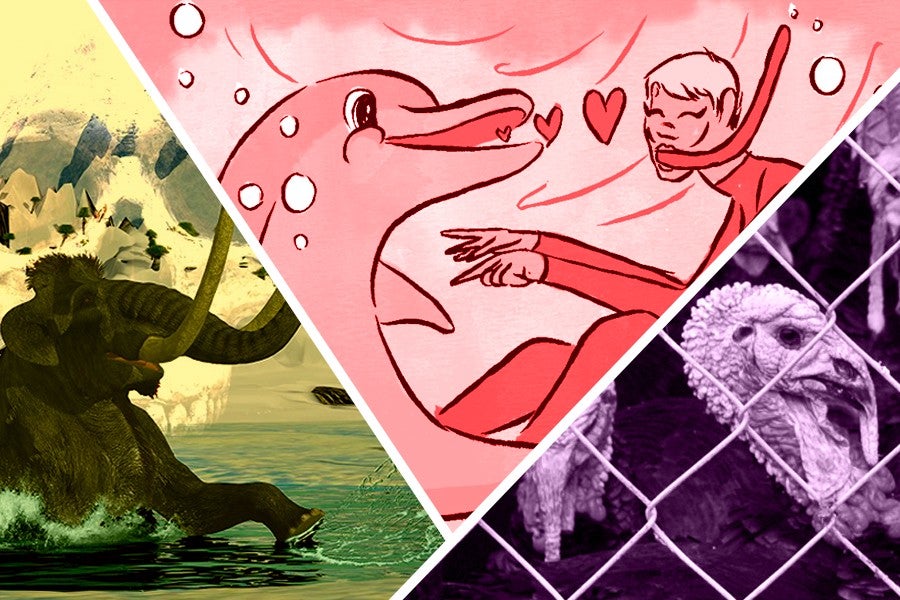We learned a lot from each other this year, but we also learned a lot from our animal pals. From fruit flies teaching us why we get in each others’ faces to penguins giving us an insight into the millennial/parent relationship, here’s what wildlife taught us in 2017.

Scientists can get really attached to their work — especially if they work with dolphins.
Back in February, writer Mallory Locklear looked at the often intimate relationship between scientists and the projects they works on. From microbes to satellites, she found that almost all researchers developed a close bond with their subjects, perhaps none more so than the one who spent months literally sleeping next to a dolphin:
“Soon after, the last of the funding dried up, the experiment was shut down, and the St. Thomas facility closed up shop. The three dolphins were flown back to Florida, including Peter. Howe, for her part, stayed behind. ‘He wasn’t mine. I couldn’t keep him,’ Howe said [of Peter the dolphin] in the documentary. She describes getting misty-eyed during her last day with Peter, ‘Because at that point I knew and Peter didn’t know.’”
Penguins don’t know what to do about their millennial children, either.
In March, staff writer C. Brian Smith examined the news that, as parents, penguins are total suckers:
“Another survey from USA Today found that more than 30 percent of willing parents justified assisting their adult children because ‘they really needed help’ and nearly the same amount said they ‘felt it was their parental responsibility.’ Apparently that’s exactly how the parents of equatorial penguins feel, too: University of Washington biology professor Dee Boersma recently returned from the Galápagos Islands, where she found that grown-up Galápagospenguins never stop begging their parents for food, and penguin moms and dads never stop obliging.”
A dog in a tux is all you need to make a perfect wedding.
As wedding season approached in June, Smith decided to track down the woman who wrote the book on officiating pet weddings. Her advice was… special?
“‘I really hate to be that person who says ‘put your dog in a tux,’ but I think we need as much joy as we can muster,’ Brockway explains. “While some people may roll their eyes, it can add a sense of occasion. When the family dog makes an entrance in a dress or suit in human weddings it gets more ooohs and ahhhhs than the precocious 2-year-old walking down the aisle like an angel. But a reminder: Dogs do not like clothes and do not require them. It’s all for we humans.’”
Thanks to fruit flies, we now know why some people have no concept of personal space.
There are few things more annoying that someone who’s completely oblivious to your personal space bubble. And thanks to research on our little fruit-bothering pals, we have a reason for it, as reported by senior editor Nick Leftley in August:
“An experiment with fruit flies — people love doing experiments on fruit flies! — has found that dopamine (the brain’s ‘reward’ chemical, also a huge part of addiction issues) can affect the size of your preferred personal space ‘bubble.’ Too little dopamine caused the male flies to want to get the hell away from each other, while too much made them all touchy-feely. (For the lady fruit flies, either too little or too much increased their need for distance.) Ultimately, it’s hoped that the research might help explain and treat those who struggle to deal with, or understand the rules of, social interaction. Frankly, we’d settle for a way to get rid of the damn fruit flies — oh, wait, no, they’ve already experimented with that, too.”
We can only truly enjoy a movie if we know the dog’s going to be okay.
In October, contributing editor Tim Grierson examined why movie audiences feel so strongly about animals onscreen — to the extent that Fox put out a spoiler reassuring moviegoers that, don’t worry, the dog survives The Mountain Between Us. Here’s what he found out:
“In 2013, Northeastern University tried to find an explanation for this panicked reaction in some viewers, charting the reaction of 240 locals who ‘randomly received one of four fictional news articles about the beating of a 1-year-old child, an adult in his 30s, a puppy or a 6-year-old dog. The stories were identical except for the victim’s identity. After reading their story, respondents were asked to rate their feelings of empathy towards the victim.’ The study found that the victim who received the least amount of empathy was the adult in his 30s. As one of the study’s authors, a professor of sociology and criminology, put it, ‘It appears that adult humans are viewed as capable of protecting themselves,’ which lessened the subjects’ compassion toward them.”
Being unpopular will kill you (if you’re a male killer whale, at least).
Loneliness is always an issue for humans, but spare a thought for young male orcas, because in their case, it can be downright lethal. That’s what Leftley learned when he reported this research in October (and then tried to find some useful online advice for the poor blubbery fellas):
“If you’re a male killer whale — according to a new joint study from the Center for Whale Research and the British universities of Exeter and York — loneliness can absolutely kill you. More isolated male orcas, in fact, were found to be three times more likely to die in any given year than males in the ‘most central social positions.’ To put this in high-school terms, that guy Gary who sometimes sits at the end of your lunch table by himself, but who you don’t actually talk to, is 300 percent more likely to be dead by summer break than literally every single guy on the football team.
“The reason for this, say the researchers, is that killer whales are a highly cooperative bunch when it comes to hunting. Males on the outskirts of the group are less likely to get their share of the grub come supper time, and so, they slowly starve to death. Again, like that guy Gary, only if his unpopularity were so great that even the lunch ladies refused to serve him.”
It’s fine to let your dog sleep in your bed. And it’s fine not to. Whatever.
After new research was released showing that people who let their dogs sleep in their beds slept (pretty much) as well as those who didn’t, assistant editor Ian Lecklitner took a look at why we even let those filthy mutts into our bedrooms in the first place:
“As for why some people sleep better with their dogs nearby, certified clinical sleep educator Terry Cralle believes it has to do with comfort and a sense of security. ‘I talk to people all the time who swear they sleep much better with their pets — say, a cat curled up on their feet,’ she explains. ‘Some people love the warmth, comfort and security, reporting that it’s extremely difficult to sleep without their pets nearby.’”
Woolly mammoths were the first males who’d rather die than ask for directions.
The stand-up cliche goes back further than we thought — tens of thousands of years, in fact, as reported by Leftley in November:
“A report in Current Biology details the efforts of researchers to figure out why, of the 98 existing specimens of woolly mammoths on record, almost 70 percent of them are male. The answer? Male mammoths were far more likely to get lost and blunder into some kind of “natural trap,” like falling through lake ice, or sinking into a bog (or, y’know, driving a scooter into a sinkhole).
“The report explains that while most herds consisted of females and young mammoths led by a mature, experienced female, the young, male, bachelor-about-town type mammoths liked to wander off on their own. Without the guidance of said experienced female, a combination of ignorance and risky behavior would frequently be their undoing. It’s likely, in other words, that for at least half the mammoth skeletons you’ve ever seen in museums, that animal’s last words were some variation of, ‘Watch this!’”
Your ancestry matters, at least in regards to how good you taste.
As Thanksgiving loomed, contributing writer Layton Ehmke visited a heritage turkey farm to see why anyone would care about their dinner’s ancestry. He learned a lot:
“‘I had some industrial birds here and I treated them like my birds — fed them the same thing I would mine,’ says Frank Reese, the most influential poultry breeder in the country. ‘What was so sad is that those poor turkeys wanted to run, wanted to jump, wanted to move, and they just sat. The brain wanted to be normal, but they were physiologically incapable of doing those normal things. If we expect better health out of ourselves, shouldn’t we expect better from our meat?’
“Modern industrial turkey breeders have bred a hybrid big-breasted white turkey that’s so large it can’t reproduce on its own, which is where artificial insemination has been useful. Plus, AI allows commercial breeders to better control the sexes of the birds so they can raise fewer toms, since toms have a lower rate of hatchability. No matter the sex, once hatched, the turkeys’ beaks and toes are trimmed before they’re vaccinated and sent to a grow-out farm to put on considerable amounts of weight. ‘Theirs is the ratio of growth-to-feed,’ Frank explains. ‘‘How much muscle mass can we get for the least amount of feed?’ All of the bird’s problems — like bad legs, congestive heart failure and liver disease — can be treated with antibiotics or vaccines. But I was taught to raise a balanced bird. If one characteristic like reproduction is picked over any other thing, you’re out of balance.’
“‘And so, the industry is out of balance,” Frank continues. ‘Did you know that every chicken you buy in the store is one genetic animal? There’s absolutely no difference between each bird. You can call it whatever you want: Organic or free range, but it’s the same genetic thing. And guess what Mother Nature doesn’t like: Monoculture. Look at the potato famine. It’s not a matter of if, but when it’s going to come back and bite us.’”
Speaking of poultry, geese are metal as fuck.
So mess with them at your peril:

